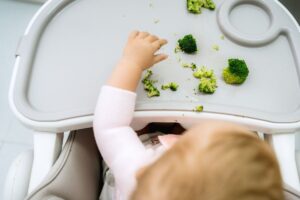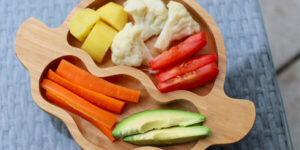Starting your baby on solid foods is an exciting milestone in your little one’s development – it doesn’t only open them up to an exciting new world of taste and textures, but it also helps them to grow.
When to Start Baby Food
Knowing when to wean your baby off 100% breast milk or formula milk can be tricky. Introducing your baby to solid food too early may cause digestive problems and starting them on solid foods too late may slow their growth and development.
Experts recommend that about 6 months is the optimum time to introduce solid foods into your baby’s diet, however, they should show ALL of the below signs before you think about them eating solids.
Fortunately, there are some easy ways for you to identify when to start your baby on their first foods. Let’s take a look below:
- Baby can sit upright in a high chair (unaided) with minimal support
- Baby displays good head control
- Baby looks interested at mealtimes and has the coordination to pick up finger foods and put it in their mouth by themselves
Introducing solid foods
Between 4-6 months, most of your baby’s nutrition will still come from breast milk or infant formula, so don’t get too disheartened if they aren’t taking to spoonfeeds or finger foods straight away. Introducing baby solid foods is a gradual process, and every baby learns at their own pace.
When starting solid foods, a small amount will do at first — the best thing you can do is to sit down and eat with your baby. Don’t pressure or try to sneak food into their mouth.
I recommend weaning with single-ingredient foods such as vegetables, or you can also try starting them on infant cereal like baby rice or fortified smooth oat cereal (e.g. Ready Brek) mixed with your baby’s usual milk.
It’s important to introduce your baby to potentially allergenic foods from 6 months, in small amounts, so that you can help to prevent food allergies. Foods you should slowly introduce are:
- cow’s milk (in cooking or mixed with food)
- well-cooked eggs
- foods that contain gluten, including wheat, barley and rye
- nuts and peanuts (serve them crushed or ground or even try peanut butter)
- seeds (serve them crushed or ground)
- soya
- fish
Learn more: A step-by-step guide to the introducing potential allergens.
Introducing vegetables
Vegetables are really great finger foods and ideal for baby-led weaning. It’s important to introduce your baby to vegetables as soon as you can as they are full of all the essential vitamins and minerals your little one’s body needs to thrive. Research has also found that babies who are introduced to vegetables first are more likely to enjoy eating them when they get older. The key is to give your baby single vegetables at each meal but repeat them often so your baby gets used to their taste.
Read more: Vegetable-first weaning
Below, we look at some of the best veggies you can start to feed your baby and why they’re so good. You’ll see that I’ve chosen a range of colours from green, orange and red. Feeding your baby a ‘rainbow’ of coloured vegetables offers the widest range of nutrients. And it’s a feast for the senses too!
From a spoon or baby-led weaning?
You can serve ANY of these veggies either puréed or mashed from a spoon. Just cook if needed and blend or mash to the desired consistency. Serving them as baby-led options needs a little more thought and so I’ll give you tips on how to serve each one safely.
Learn more: Baby led weaning, spoon feeding: The great debate!
7 great vegetables for your weaning baby
Avocado
Avocados aren’t just a trendy food, they’re also extremely healthy and a great choice for your baby’s first foods. Avocados are high in potassium, fibre, and healthy monounsaturated fats, and they’re easy to prepare!
How to serve Avocado for baby-led weaning?
If you’re giving your baby avocado for the first time, I recommend cutting ripe avocado into large, thick spears or mashing it together and serving on a spoon. If the avocados are continually slipping out of your little one’s hands, try rolling the pieces in food that adds grip such as ground seeds, ground nuts or shredded (dried coconut) coconuts or fortified iron-rich cereal like Ready Brek.
 Carrots
Carrots
When you start solid foods with your baby, you want to ensure you’re giving them all the nutrients they need to grow big and strong, and with carrots, you can rest assured you are!
How to serve Carrots for baby-led weaning?
Carrots can be enjoyed by your baby in a variety of ways, although I would recommend cutting it into sticks and then steaming it as this will be nice and soft and easy for your baby to pick up with their hands.
Later on try these easy cheesy carrot flapjacks.
Roasted Sweet Potato
Sweet potatoes are at the top of the list when it comes to the first foods to introduce to your baby. Not only are they a great source of dietary fibre, but they contain lots of Vitamins A.
How to serve Roasted Sweet Potato for baby-led weaning?
The great thing about roasted sweet potatoes is that they can be enjoyed by all the family. I suggest slicing your sweet potato into finger-sized wedges ensuring they’re big enough for little hands to hold, before covering in some oil and placing on a baking tray in the middle of a pre-heated oven for 30 minutes.
Allow the sweet potato to properly cool down before giving it to your baby and watch them enjoy the same food as you! Remember, That’s always the goal with weaning.
 Broccoli
Broccoli
Broccoli is one of the number one foods you can offer your baby as it contains a number of vitamins and minerals that babies need to develop, including vitamins C, A, B6, folate and even a little bit of protein and calcium. And it’s a vegetable that most families eat regularly throughout the week. And it’s easily available either fresh or in the frozen food section.
How to serve Broccoli for baby-led weaning?
While Broccoli isn’t at the top of the list for choking hazards, you should take plenty of caution to prepare and cut it properly for your baby. To minimise the chance of choking, you should steam the broccoli until soft and tender.
Top tip: if you serve broccoli florets (stem on) upside down, it makes it easier and more attractive for your baby to pick up and eat the soft floret top!
Green Beans
Green Beans are a great source of Vitamins, A, C and K – which are all essential for your baby’s growth and development. They also help to fuel your baby’s body with protein and help to ease symptoms of constipation as they’re full of fibre! They even contain a little bit of calcium.
For more help on preventing constipation during weaning check out this blog.
How to serve Green beans for baby-led weaning?
Green beans are particularly tough for babies to chew, so ensuring that they’re cooked properly will help. We (I) suggest placing green beans in a steamer for 5 minutes, until they are nice and soft, before rinsing under cold water to stop the cooking process.
You should ideally feed your baby cooked green beans whole until they reach their first birthday, as the choking hazard becomes significantly less and they are also really easy for little hands to pick up!
Frozen Peas
Frozen Peas are great first foods for your little ones. They contain plenty of fibre, protein, and are packed with Vitamins A, and C . And they’re super handy to have stashed in the freezer!
How to serve Frozen Peas for baby-led weaning?
As frozen peas can be a choking hazard, you should aim to blend peas into a paste-like consistency and serve in a bowl or on top of a small piece of toast or bread. Alternatively, squash them or halve them and serve once your baby has mastered their pincer grip at about 9 months.
Cherry tomatoes
Introducing foods to your little one couldn’t be any easier than with this raw vegetable. Well, actually they’re technically a fruit! Not only are they incredibly tasty, but they have tonnes of Vitamin C, and are packed with Lycopene which has anti-inflammatory properties. They’re also rich in potassium and vitamin A.
How to serve for baby-led weaning?
Because this veggie can be a choking hazard, you want to ensure they are cut into quarters or bite-sized pieces. We typically recommend feeding your baby cherry tomatoes from the age of 9 months to minimise the risk.
Of course, this is only a small selection of the vegetables that you can serve to your baby. No one vegetable is better than any other, and as always the goal is to introduce your baby to a variety of your family foods. So, offer your baby whatever you’re eating. Just make sure to modify the texture for safety. And don’t get stuck in a rut. Try to throw a different selection into your trolley every week. Variety is the key! And buying what’s in season means it’s cheaper, more sustainable and more nutritious.








0 Comments